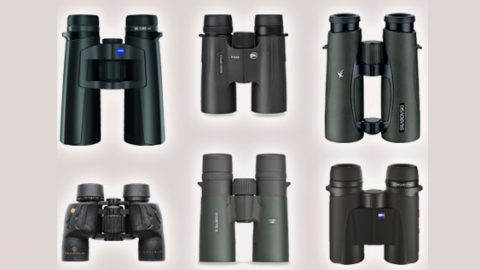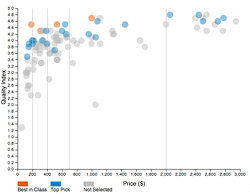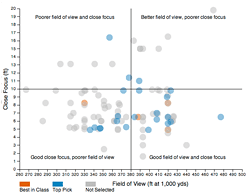Finding the Best Binoculars for Birding
By Jessie Barry and Ken Rosenberg
October 15, 2013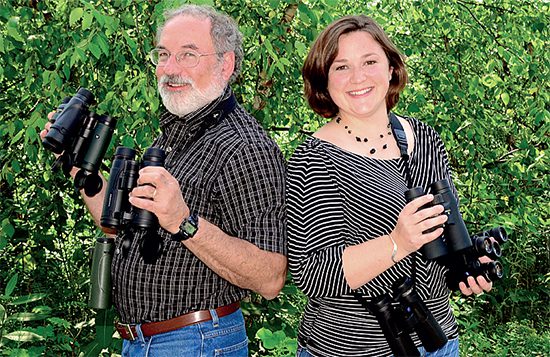
Selecting binoculars is a lot like tasting wines. It takes most people years of experience to be able to notice subtle differences in quality and articulate preferences using just the right lingo. Personal preference plays a large role in picking favorites. You could sip one of the world’s finest chardonnays and dislike the smooth, buttery finish derived from the oak barrels. In the same way, you might turn your nose up at the open-bridge design of a pair of top-of-the-line Swarovskis, a feature adored by many.
In optics as in wines, there is a large spectrum of prices, subtle differences are many, and the process of selecting one or describing why you like a particular one can be intimidating. Wines and binoculars follow the same general rule: you get what you pay for, and purchasing the best you can afford almost always pays off. That said, you don’t need to be a master sommelier or professional optics rep to make a good decision. In whatever price range you choose, when all is said and done, we hope you will feel that you’ve gotten good value for your money.
As you select new binoculars, we encourage you to try several pairs on your own and figure out what you like, if you haven’t already done so. In this review we showcase some of the favorites based on ratings by our 60 “tasters”—including optics aficionados and casual and hardcore birders—as well as our own personal experience. Rather than provide a comprehensive list of the specifications and ratings for all of the binocular models we tested, the optics presented here are our Top Picks in each price category—those we feel are the best value, optically solid, and ergonomically comfortable. For the full report, visit our website at www.birds.cornell.edu/binos. We aim to help you find binoculars that will fit you and your birding style.
A disclaimer: testing binoculars follows another important rule of wine tasting. After tasting a flight of wines, they all start to taste the same. We found this to be true after testing a lineup of binoculars. After a while, as your eyes get tired, it’s harder to discern differences.
What’s New?
Since our last full binocular review in 2005, the sheer number of binocular models has steadily increased, and fortunately so has the overall quality of models in all price ranges. Although the price tag for the top models has crept toward the $3,000 mark, optics-makers have also improved optical performance with new types of glass, new lens coatings, and new ergonomic features that reduce weight and bulk. A relatively compact and fully waterproof roof-prism design, with high-quality, close-focusing optics, adjustable twisting eyecups, and excellent eye-relief are all now standard for models in nearly every price range.
Readers will recognize many familiar binocular brands among our Top Picks, but some new names—Alpen, Atlas, Opticron (popular in the United Kingdom), Vixen, and Zen-Ray—now vie for birders’ attention. Competition for brand loyalty among a growing and ever-more-discerning birder market has also fueled a trend toward greater corporate attention to service, sustainability, and support for birding and conservation programs. Along with fine optics, birders can now expect lifetime service warranties, superior customer support, and company presence at birding festivals and on conservation websites.
Things to Consider
With all that’s new and exciting in the world of binoculars, the same basic principles still apply for choosing the right binoculars for your birding needs. The daunting task of selecting from among the dozens of binocular models available can be made simpler by considering the following options.
Price: In general, we recommend spending as much as you can afford on binoculars, because a higher price usually indicates (with some exceptions) higher quality and durability. We were excited, however, by the excellent choices in the lower and midpriced categories. We’ve selected our Top Picks in each of five price ranges. Although many birders always opt for the latest top-of-the line binoculars, several models in the “New Midrange” are so nice, they really make us wonder whether the extra $1,000 to $2,000 might be better spent on a trip to an exotic birding destination or to help support your favorite bird organization. For birders on a tight budget or educators looking to buy several binoculars, we were pleased to see a few remarkably good models for under $200—although how well these hold up under rugged or wet field conditions remains to be seen. Please note: the prices we list are the manufacturer’s suggested list prices; you can often find lower prices than these online or at discount retailers.
Magnification: Nearly all of the models we tested come in a choice of 10x or 8x (or sometimes 7x) magnification, and because they are usually so similar in design and overall quality, we present review data mostly for the 8x models. Selecting 8x or 10x is highly subjective, with strong opinions among birders on both sides. Whereas some birders prefer using higher magnification to discern greater feather detail and for long-distance birding (for example, hawk watching, seabird watching, or peering into the rainforest canopy), others prefer the slightly brighter image and wider field of view offered by 7x or 8x binoculars. Hand-shake can also be an issue for people who are not used to 10x binoculars, but this also depends on the weight and ergonomics of the particular model. If you opt for lower-priced binoculars (under $400), we generally recommend using only lower-magnification models.
Ergonomics and eyeglass friendliness: As with wines, the many subtle variations in binocular design make it all the more important to “taste” as many binoculars as you can before buying. Our reviewers made copious comments on the weight, balance, ease and closeness of focus, and overall feel of each model. There were as many opinions as there were sizes and shapes of hands and faces, with each reviewer keying in on different features. If you wear eyeglasses while birding, eye-relief is the all-important metric, and fortunately most binoculars now provide an excellent image for us bespectacled types.
Corporate sustainability and conservation: With so many choices in binocular manufacturers and distributors, consumers may also consider what the companies give back to the birding community and to conservation. Several optics companies are major contributors to nonprofit birding and conservation organizations, support bird expeditions or research projects, or provide optics for international birding guides and students. Here at the Cornell Lab, for example, we are particularly grateful for generous support from Zeiss and Swarovski Optik and for their long-term commitment to our mission. We urge all companies to support these important activities and publicize them to the birding community.
Our Methodology
To sort through the mounds of binoculars we received for review, we used a similar approach to past reviews, assembling a small army of 60 “binocular-tasters” on the patio at the Cornell Lab of Ornithology for several days in May. On our first afternoon, a locally rare Prothonotary Warbler fed along the edge of Sapsucker Woods pond, bedazzling reviewers who got to compare its beauty side-by-side through a wide range of optics. We asked each taster to rate at least five binocular models on a 1-to-5 scale, in terms of (1) clarity and crispness of image, (2) overall feel (ergonomics, weight, ease of focus), (3) eyeglass friendliness (eye-relief and sturdiness of the eyecups), and (4) overall performance (“Would you buy these binoculars?”). We then combined these ratings with our own rankings to derive an overall Quality Index, presented as the familiar “1-star” to “5-star” rating. Below we provide our Top Picks in each of five price categories.
Top Picks
Top-of-the-line ($2,000 to $2,775, median $2,400)
When crafting the world’s finest burgundy or pinot noir, wine-makers take extreme care every step of the way. Creating the world’s finest optics is very similar. This category brings together an outstanding suite of products. Choosing among the Top Picks comes down mostly to your personal preference. “Tasting” them for yourself is an important step, but at the same time you really can’t go wrong with any of the top models. We decided not to name a “Best in Class” for this top category, because the “tasters” scores were so similar. Among the 15 models in this category, the Zeiss Victory T* HT, Swarovski Swarovision, and Leica Ultravid HDs were the three favorites. Some people were critical of the warping, or “fishbowl” effect, apparent in the new Swarovisions, more so in the 8x than 10x models. Our reviewers also loved several top-of-the-line 8×32 binoculars, which offer the same exceptional optical quality in a smaller, lighter, and less-expensive option. Although the 8x32s may not be as bright in low-light conditions, we believe their benefits may outweigh the rare situations when someone might need that extra bit of light. Get full recommendations, ratings, and specs for all our Top Picks in our online review.
★ ★ ★ ★ ★ Zeiss Victory T* HT 8×42 (29.5 oz.) $2,444
★ ★ ★ ★ ★ Swarovski Swarovision 10×42 EL (29.8 oz.) $2,777
★ ★ ★ ★ ★ Zeiss Victory T* FL 8×32 (21.7 oz.) $2,055
★ ★ ★ ★ ½ Leica Ultravid HD 8×42 (29.5 oz.) $2,099
★ ★ ★ ★ ½ Swarovski Swarovision 8×32 (20.1 oz.) $2,399
★ ★ ★ ★ ½ Leica Ultravid HD 8×32 (21.3 oz.) $1,899
The New Midrange ($700 to $1,999, median $1,050)
A decade ago, $1,000 was the going rate for top-of-the-line binoculars. These days, high-end optics cost upwards of $2,000, and optics companies have introduced an entirely new class of binoculars around the $1,000 price point. This begs the question, is it worth paying an extra $1,000? This is a question you should answer by trying the binoculars for yourself. We can say several exceptional choices have emerged in this new class. The Zeiss Conquests, particularly the 8x32s, were among the top-scoring binoculars in the entire review. Optically, you will notice a step-up in the high-end category if you are pushing the boundaries of bird identification, trying to resolve differences in seabirds or raptors that are just pepper flakes in the sky. For many birders, however, our Top Picks in the New Midrange will serve you well. We reviewed 21 binoculars in this category, and found Zeiss Conquest, Leica Trinovid, and Vortex Razor led the class. Get full recommendations, ratings, and specs for all our Top Picks in our online review.
★ ★ ★ ★ ★ Zeiss Conquest HD 8×32 (22.4 oz.) $999 (Best in Class)
★ ★ ★ ★ ½ Zeiss Conquest HD 8×42 (28.0 oz.) $1,077
★ ★ ★ ★ ½ Leica Trinovid 8×42 (31.0 oz.) $1,449
★ ★ ★ ★ ½ Vortex Razor HD 8×42 (25.5 oz.) $1,279
★ ★ ★ ★ Swarovski CL 8×30 (23.5 oz.) $1,054
★ ★ ★ ★ Meopta Meostar 8×32 (21.5 oz.) $959
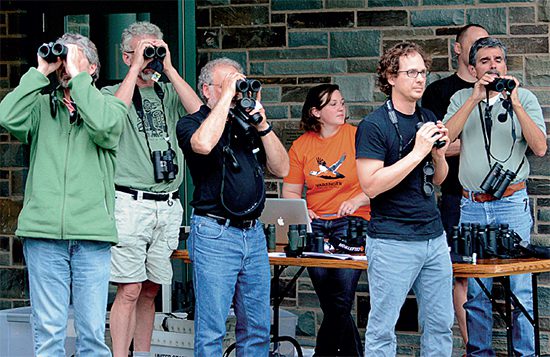
The 400 to 699 Club ($425 to $680, median $530)
There seem to be more and better options in this class each year, with several models offering glass and coatings traditionally used only in high-end optics. All of the Top Picks include ED (extra-low dispersion) or HD (high-definition) glass, designed to enhance contrast, resolution, and color. We tested 27 pairs in this class and found five excellent options. Leading the pack were the Nikon Monarch 7 series 8x42s, the high end in the completely redesigned Monarch line, which ruled the midprice class in past reviews. These offer exceptional value, with a sharp, bright image in a comfortable and fully waterproof body. Nearly identical in terms of reviewer scores, but a bit heavier and pricier were the Opticron Verano BGA HD. Other very good options include the Celestron Granite ED, Eagle Optics Golden Eagle HD, and Vortex Viper HD. Get full recommendations, ratings, and specs for all our Top Picks in our online review.
★ ★ ★ ★ ½ Nikon Monarch 7 8×42 (22.6 oz.) $530 (Best in Class)
★ ★ ★ ★ ½ Opticron Verano BGA HD 8×42 (27.6 oz.) $641
★ ★ ★ ★ ½ Celestron Granite ED 8×42 (26.1 oz.) $440
★ ★ ★ ★ ½ Eagle Optics Golden Eagle HD 8×42 (25.7 oz.) $600
★ ★ ★ ★ Vortex Viper HD 8×42 (24.2 oz.) $655
The 200 to 399 Club ($210 to $399, median $315)
This group offers remarkable quality for the price. You can even get high-quality ED glass in the Nikon Monarch 5 and Zeiss Terra ED. This category is a mix of longtime favorites including the Nikon Monarch (the 5 is definitely worth the price and a step up from the Monarch 3) and Eagle Optics Ranger. Zeiss Terras are brand new, and represent Zeiss’s first attempt to offer a binocular in this price range. The Opticron Trailfinder 3 WP and Vixen New Foresta HR WP are newer to the North American birding scene and offer diversity to the Top Picks. We reviewed 24 binocular models in this class. Get full recommendations, ratings, and specs for all our Top Picks in our online review.
★ ★ ★ ★ ½ Nikon Monarch 5 8×42 (20.8 oz.) $309 (Best in Class)
★ ★ ★ ★ ½ Zeiss Terra ED 8×42 (25.4 oz.) $385
★ ★ ★ ★ Opticron Trailfinder 3 WP 8×42 (27.0 oz.) $219
★ ★ ★ ★ Eagle Optics Ranger 8×42 (22.1 oz.) $333
★ ★ ★ ★ Vixen New Foresta HR WP 8×42 (25.0 oz.) $399
Budget Bins (under $200, median $155)
If you are on a tight budget, the options in this price range have never been better. Reviewers were stunned to learn the price of the Celestron Nature DX, after rating them as highly as models many times their price, and the Opticron Oregon 8x32s could well be the best binoculars we’ve seen for kids. Among the remaining 16 models we tested, the Leupold Yosemites are very decent for the low price, and they are available in 6x, 8x, and 10x models. Educators looking to purchase binoculars in quantity to lend to visitors or to outfit a class or afterschool group are unlikely to be disappointed with any of our Top Picks. It’s worth noting, though, that spending less than $100 on a pair of binoculars is likely to lead to a relatively poor birding experience or the need to upgrade quickly; also, we have yet to find a pair of compact binoculars that we would recommend for serious birding. Get full recommendations, ratings, and specs for all our Top Picks in our online review.
★ ★ ★ ★ ½ Celestron Nature DX 8×42 (23.4 oz.) $185 (Best in Class)
★ ★ ★ ★ Atlas Optics Sky King 8×42 (26.7 oz.) $199
★ ★ ★ ★ Opticron Oregon LE WP 8×32 (19.5 oz.) $155
★ ★ ★ ★ Eagle Optics Denali PC 8×42 (22.6 oz.) $199
★ ★ ★ ★ Optics Planet OPMOD 8×42 (24.7 oz.) $195
★ ★ ★ ½ Leupold BX-1 Yosemite 8×30 (19.0 oz.) $129
Conclusion
With so many excellent binoculars on the market, choosing just one pair can be overwhelming, but take comfort in the fact that the overall selection is improving. Binoculars are an essential tool, providing a spectacular window into the natural world for birders and other nature enthusiasts. We hope this review is helpful and that you find a pair of binoculars that suits you. To view a chart rating all of the binoculars tested in this review, visit our website at www.birds.cornell.edu/binos. ♦
Jessie Barry is a member of Team Sapsucker, the Cornell Lab’s Big Day team, and is project leader of Merlin, a new bird-identification app being developed at the Lab. Ken Rosenberg is a conservation biologist at the Cornell Lab and a longtime aficionado of birding optics.
Acknowledgments
We’d like to thank the staff of Wild Birds Unlimited at Sapsucker Woods for their patience in generosity in allowing us to test and re-test many of their binoculars during this review: Barry and Sue Stevens, Walt Blodget, Elise Dentes, Ann Perna, and Ann Spinelli.
We also thank the more than 60 Cornell Lab staff and local bird watchers who provided ratings for binoculars: Joanne Avila, Bernd Blossey, Nick Bruns, Shannon Buckley, Tilden Chao, Russ Charif, Miyoko Chu, Greg Delisle, Henk den Bakker, Marc Devokaitis, Martha Fischer, Tom Fredericks, J. Grenier, Emily Griffiths, Yiaing Guo, Kim Haines-Eitzen, Becky Hansen, Greg Heist, Wesley Hochachka, Marshall Iliff, Eduardo Iñigo Elias II, Sara Keen, Anne Klingensmith, Gary Kohlenberg, Stuart Krasnoff, Amanda Larracuente, Nicola Leckie, Tim Lenz, Pat Leonard, Alberto López, David McCartt, Kevin McGowan, Bill Michener, Charles Mollenhauer, Will Morris, Diane Morton, Mary P., Chris Pelkie, Ruth Pfeffer, Alicia Plotkin, Hugh Powell, Mike Powers, Ashik Rahaman, Syed Rehman, Anne Rosenberg, Jesse Ross, Tom Schulenberg, Sharon, Aisha Siebert, Laura Stenzler, Rob Stevenson, Jae Sullivan, Derrick T., Don Timmons, Benjamin Van Doren, Brad Walker, Peter Wiedmann, Andrea Wiggins, Chris Wood, Suan Yong, and Matt Young.

All About Birds
is a free resource
Available for everyone,
funded by donors like you
American Kestrel by Blair Dudeck / Macaulay Library
